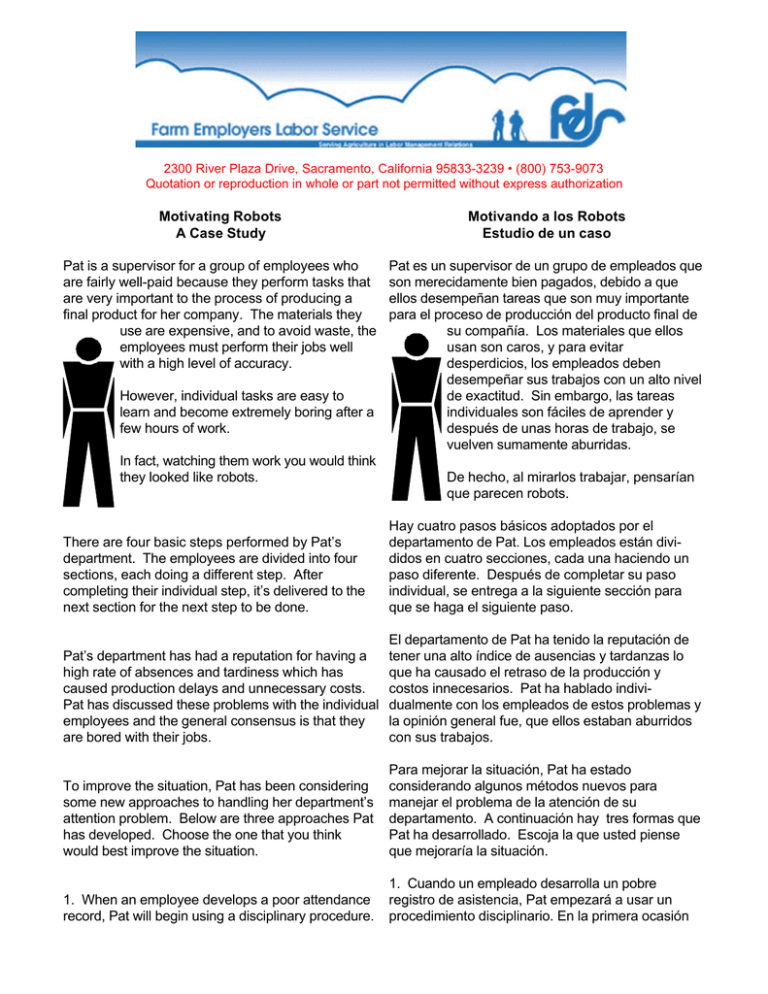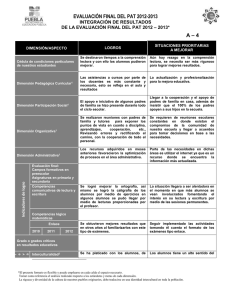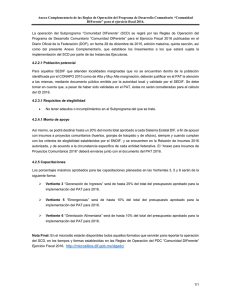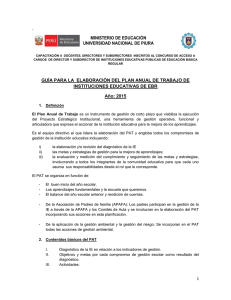C:\Data\FELS\Supervisor Spotlight\SSL
Anuncio

2300 River Plaza Drive, Sacramento, California 95833-3239 • (800) 753-9073 Quotation or reproduction in whole or part not permitted without express authorization Motivating Robots A Case Study Motivando a los Robots Estudio de un caso Pat is a supervisor for a group of employees who are fairly well-paid because they perform tasks that are very important to the process of producing a final product for her company. The materials they use are expensive, and to avoid waste, the employees must perform their jobs well with a high level of accuracy. Pat es un supervisor de un grupo de empleados que son merecidamente bien pagados, debido a que ellos desempeñan tareas que son muy importante para el proceso de producción del producto final de su compañía. Los materiales que ellos usan son caros, y para evitar desperdicios, los empleados deben desempeñar sus trabajos con un alto nivel de exactitud. Sin embargo, las tareas individuales son fáciles de aprender y después de unas horas de trabajo, se vuelven sumamente aburridas. However, individual tasks are easy to learn and become extremely boring after a few hours of work. In fact, watching them work you would think they looked like robots. De hecho, al mirarlos trabajar, pensarían que parecen robots. There are four basic steps performed by Pat’s department. The employees are divided into four sections, each doing a different step. After completing their individual step, it’s delivered to the next section for the next step to be done. Hay cuatro pasos básicos adoptados por el departamento de Pat. Los empleados están divididos en cuatro secciones, cada una haciendo un paso diferente. Después de completar su paso individual, se entrega a la siguiente sección para que se haga el siguiente paso. Pat’s department has had a reputation for having a high rate of absences and tardiness which has caused production delays and unnecessary costs. Pat has discussed these problems with the individual employees and the general consensus is that they are bored with their jobs. El departamento de Pat ha tenido la reputación de tener una alto índice de ausencias y tardanzas lo que ha causado el retraso de la producción y costos innecesarios. Pat ha hablado individualmente con los empleados de estos problemas y la opinión general fue, que ellos estaban aburridos con sus trabajos. To improve the situation, Pat has been considering some new approaches to handling her department’s attention problem. Below are three approaches Pat has developed. Choose the one that you think would best improve the situation. Para mejorar la situación, Pat ha estado considerando algunos métodos nuevos para manejar el problema de la atención de su departamento. A continuación hay tres formas que Pat ha desarrollado. Escoja la que usted piense que mejoraría la situación. 1. When an employee develops a poor attendance record, Pat will begin using a disciplinary procedure. 1. Cuando un empleado desarrolla un pobre registro de asistencia, Pat empezará a usar un procedimiento disciplinario. En la primera ocasión On the first occasion she will counsel the employee in an attempt to explain why it is necessary for the employee to be on time and how the absence affects the other employees. If the problem occurs again, Pat will give the employee a written warning, with an explanation that on the next occurrence the employee will be terminated. On the third violation, Pat will terminate the employee. By taking this approach, Pat believes she will be communicating to the other employees that the company will not tolerate a poor attendance record and terminating will “shape up” the other people in the department. 2. When an employee begins to have an attendance problem, Pat will discuss the problem with the employee. However, as opposed to Solution #1, she will attempt to determine the reason for the tardiness or absence. If the reason is legitimate, she will excuse the employee and attempt to help the employee improve his or her attendance. Pat may change the work schedule or alter the work in some way. If the employee says the problem is because the job is boring, Pat will reassign that person to another step in the production line in order to give the employee some variety of work. However, if the problem continues, Pat will either find the employee another department in which to work or terminate the employee. 3. Pat’s final solution is to discuss the problems with all employees during a departmental meeting. In doing so, Pat hopes the employees will come up with some ways to solve the problem. By discussing the problem openly with the employees, Pat hopes they will also understand why they are absent or tardy. It’s Pat’s hope that the employees will make suggestions about how to make the job less boring. Would you pick one solution to this problem or a blend of solutions? ella aconsejará al empleado intentando explicarle por qué es necesario que el empleado esté a tiempo y cómo afecta la ausencia a los otros empleados. Si el problema ocurre nuevamente, Pat le dará una advertencia escrita al empleado, con una explicación de que en la próxima vez que ocurra, el será despedido. En la tercera violación, Pat despedirá al empleado. Al usar este método, Pat cree que ella estará comunicando a los otros empleados que la compañía no tolerará un pobre registro de asistencia y que el despido les pondrá "en forma" a los otros empleados del departamento. 2. Cuando un empleado comienza a tener un problema de asistencia, Pat hablará del problema con el empleado. Sin embargo, opuesto a la Solución #1, ella intentará de determinar la razón por la tardanza o ausencia. Si la razón es legítima, ella excusará al empleado e intentará ayudar a que mejore su asistencia. Pat podría cambiar el programa de trabajo o podría alterar de alguna manera el trabajo. Si el empleado dice que el problema es porque el trabajo es aburrido, Pat le asignará otro paso en la línea de producción, para así darle alguna variedad de trabajo. Sin embargo, si el problema continúa, Pat encontrará otro departamento para que trabaje el empleado o lo despedirá. 3. La solución final de Pat, es la de hablar los problemas con todos los empleados durante una reunión departamental. Al hacer esto, Pat espera que los empleados propondrán algunas formas para resolver el problema. Al hablar abiertamente sobre el problema con los empleados, Pat espera que ellos también entiendan por qué ellos se ausentan o llegan tarde. Pat espera que los empleados harán sugerencias sobre cómo hacer el trabajo menos aburrido. ¿Escogería usted una solución a este problema o una mezcla de soluciones?




